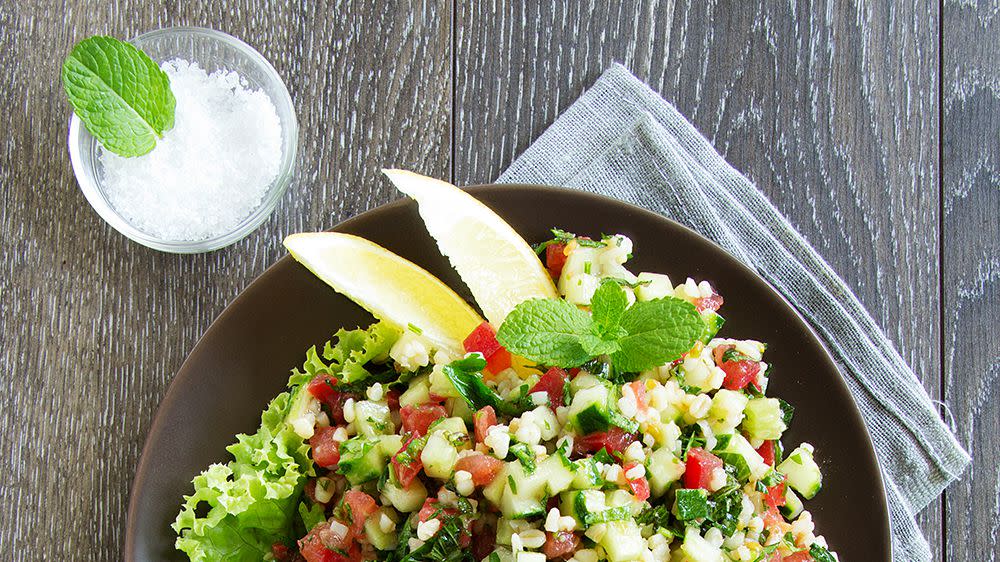The Middle Easten Diet Could Be the New Mediterranean Diet

Shutterstock
The classic Mediterranean diet is a nutritional all-star, linked to a reduced risk of heart disease, chronic inflammation, metabolic syndrome, obesity, atherosclerosis, diabetes, and even some cancers.
While you're digging into roasted salmon and munching on walnuts and veggies, you might have missed the Mediterranean diet's close cousin, the Middle Eastern diet. Just as flavorful and good for you, a Middle Eastern diet is a close relative both in geography and eating style. Middle Eastern cuisine is usually thought of as coming from countries such as Lebanon, Israel, Turkey, and Egypt. Mediterranean eating is typically associated with Italy, Greece, and Spain.
The success of the Mediterranean way of eating hinges on an emphasis on whole grains, healthy fats like olive oil and fish, legumes, nuts, and freshly sourced fruits and vegetables. Together, the combo yields high levels of fiber, omega-3 fatty acids, and a wide variety of vitamins and minerals. Middle Eastern food shares many of these same characteristics, focusing on plant-based foods as much as possible, using heavy-handed pours of EVOO just about everywhere, and sneaking beans and veggies into many preparations, including some hallmark dips. The result? A nutrient-dense diet that promotes health and longevity. Another bonus: Middle Eastern food often comes with built-in portion control as many dishes are served as a collection of small plates called mezze, similar to Spanish style tapas. Not only does this presentation style encourage you to linger and try new dishes, but smaller plates could help you lose weight. Cornell University's Food & Brand Lab found that smaller plates make you think you're eating more food than you actually are, which could trim your overall food consumption and calories.
Here, some signature dishes to get you started.
Hummus or Baba Ghanoush
Middle Eastern food is famous for its dips, perfect for dunking pita (whole wheat, of course) or raw veggies. The U.N. declared 2016 the International Year of Pulses, noting the supercharged health benefits and affordability as reasons to love the likes of chickpeas, lentils, and other legumes. Hummus, a simple combo of chickpeas, olive oil, and ground sesame seeds, is chock-full of plant-based protein, monounsaturated fats, and dietary fiber. Sneakily nutritious baba ghanoush places just behind hummus, thanks to its insane creaminess that comes from nothing other than pureed eggplants, tahini, and olive oil.
Tabbouleh or Fattoush
These two dishes are Middle Eastern spins on a Greek (Mediterranean) salad. Tabbouleh is essentially chopped parsley, antioxidant-rich tomatoes, and whole-grain bulgur. Fattoush adds a bit of toasted pita for crunchy texture but also has big chunks of veggies like radishes, cucumbers, and tomatoes to get the most bang for your nutritional buck.
Tahini
Iranian researchers found that people who incorporated tahini (a.k.a. ground sesame seeds) into their breakfast for six weeks experienced decreases in their cholesterol, triglycerides, and blood pressure. Careful on serving size, though; tahini is pretty calorie-dense, and it can be way too easy to gobble this tasty stuff up.
Fruits for Dessert
Classic Middle Eastern meals will end with dark chocolate covered dates or dried apricots. Dates provide a hefty dose of fiber and are thought to prevent chronic disease. Similarly, picking apricots as your post-dinner treat will satisfy your sweet tooth with a bonus of vitamin A, potassium, and fiber.

